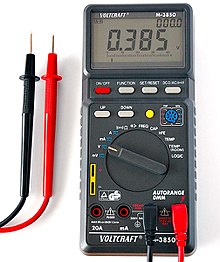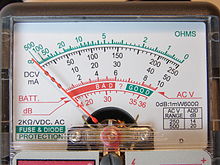Multimeter
A multimeter or a multitester, also known as a volt/ohm meter or VOM, is an electronic measuring instrument that combines several measurement functions in one unit. A typical multimeter may include features such as the ability to measure voltage, current and resistance. Multimeters may use analog or digital circuits—analog multimeters and digital multimeters (often abbreviated DMM or DVOM.) Analog instruments are usually based on a microammeter whose pointer moves over a scale calibration for all the different measurements that can be made; digital instruments usually display digits, but may display a bar of a length proportional to the quantity measured.


A multimeter can be a hand-held device useful for basic fault finding and field service work or a bench instrument which can measure to a very high degree of accuracy. They can be used to troubleshoot electrical problems in a wide array of industrial and household devices such as electronic equipment, motor controls, domestic appliances, power supplies, and wiring systems.
Multimeters are available in a wide ranges of features and prices. Cheap multimeters can cost less than US$10, while the top of the line multimeters can cost more than US$5,000.In India You Can Buy only 100 to 500 RS
Digital Multimeter

The resolution of a multimeter is often specified in "digits" of resolution. For example, the term 5½ digits refers to the number of digits displayed on the display of a multimeter.
By convention, a half digit can display either a zero or a one, while a three-quarters digit can display a numeral higher than a one but not nine. Commonly, a three-quarters digit refers to a maximum value of 3 or 5. The fractional digit is always the most significant digit in the displayed value. A 5½ digit multimeter would have five full digits that display values from 0 to 9 and one half digit that could only display 0 or 1.[3] Such a meter could show positive or negative values from 0 to 199,999. A 3¾ digit meter can display a quantity from 0 to 3,999 or 5,999, depending on the manufacturer.
While a digital display can easily be extended in precision, the extra digits are of no value if not accompanied by care in the design and calibration of the analog portions of the multimeter. Meaningful high-resolution measurements require a good understanding of the instrument specifications, good control of the measurement conditions, and traceability of the calibration of the instrument.
Specifying "display counts" is another way to specify the resolution. Display counts give the largest number, or the largest number plus one (so the count number looks nicer) the multimeter's display can show, ignoring a decimal separator. For example, a 5½ digit multimeter can also be specified as a 199999 display count or 200000 display count multimeter. Often the display count is just called the count in multimeter specifications.
Analog Multimeter

Display face of an analog multimeter
Resolution of analog multimeters is limited by the width of the scale pointer, vibration of the pointer, the accuracy of printing of scales, zero calibration, number of ranges, and errors due to non-horizontal use of the mechanical display. Accuracy of readings obtained is also often compromised by miscounting division markings, errors in mental arithmetic, parallax observation errors, and less than perfect eyesight. Mirrored scales and larger meter movements are used to improve resolution; two and a half to three digits equivalent resolution is usual (and is usually adequate for the limited precision needed for most measurements).
Resistance measurements, in particular, are of low precision due to the typical resistance measurement circuit which compresses the scale heavily at the higher resistance values. Inexpensive analog meters may have only a single resistance scale, seriously restricting the range of precise measurements. Typically an analog meter will have a panel adjustment to set the zero-ohms calibration of the meter, to compensate for the varying voltage of the meter battery.






0 comments:
Post a Comment